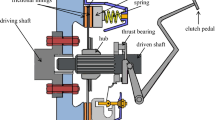Abstract
High speed and sport utility vehicles with large joint articulation angle demand lower friction in automotive driveshaft joints to meet noise and vibration comfort levels. Thus a more thorough understanding of internal friction characteristics and mechanisms is required. In this paper, a friction model in automotive driveshaft joints was developed through the use of test data from an instrumented Constant Velocity (CV) joint friction apparatus with actual driveshaft assemblies. Experiments were conducted under different realistic operating conditions of oscillatory speeds, CV joint articulation angles, lubrication, and torque. The experimental data was used to develop a physics-based semi-empirical CV joint internal friction model as a function of different CV joint operating parameters. It was found that the proposed friction model captures the experimental results well. Also the friction model estimates the generated axial force (GAF) in tripod CV joints well, which is the main source of force that causes vehicle vibration problems.
Similar content being viewed by others
Abbreviations
- b :
-
transverse width in elliptical contact
- BCD :
-
ball circular diameter at housing end view
- c si :
-
constant coefficient of static friction model
- c di :
-
constantcoefficient of dynamic friction model
- F x,y,z :
-
tri-axial friction forces inside of CV joint
- F ″′ x,y,z :
-
global forces in housing coordinate
- GAF :
-
generated axial force
- R :
-
combined radius in the direction of rolling
- R s :
-
slip ratio
- T d :
-
CV joint applied torque
- β :
-
CV joint articulation angle
- φ :
-
CV joint rotational phase angle
- λ :
-
pure rolling friction coefficient
- µ:
-
friction coefficient
- µ dyn :
-
dynamic friction coefficient
- µ GAFi :
-
friction coefficient of GAF at a trunnion
- µ S/R :
-
slip to rolling friction coefficient
- µ slp :
-
pure sliding friction coefficient
References
Fish, G. and E, J. (2002). The effect of friction modifier additives on CVJ grease performance. NLGI Spokesman 66,7, 22–31.
Halling, J. (1975). Principles of Tribology. 1st edn. Macmillan. London.
Hayama, Y. (2001). Dynamic analysis of forces generated on inner parts of a double offset constant velocity universal joint (DOJ): Non-friction analysis. SAE Paper No. 2001-01-1161.
Johnson, K. L. (1985). Contact Mechanics. 1st edn. Cambridge University Press. Cambridge.
Lee, C.-H. (2007). Measurement and characterization of friction in automotive driveshaft joints. Int. J. Automotive Technology 8,6, 723–730.
Magirius, S. and Booker, D. (1995). High speed constant velocity joints for car and light truck driveshafts. SAE Paper No. 950891.
Schmelz, F., Seherr-Thoss, C. H.-C. and Aucktor, E. (1992). Universal Joints and Driveshafts: Analysis, Design, Applications (Translated by S. J. Hill and J. A. Tipper). Springer-Verlag. New York.
Wagner, E. R. (1979). Universal Joint and Driveshaft Design Manual: Advances in Engineering. Series No. 7. Society of Automotive Engineers, Inc. Warrendale. Pennsylvania.
Author information
Authors and Affiliations
Corresponding author
Rights and permissions
About this article
Cite this article
Lee, C.H. Development of a semi-empirical friction model in automotive driveshaft joints. Int.J Automot. Technol. 9, 317–322 (2008). https://doi.org/10.1007/s12239-008-0038-1
Received:
Revised:
Published:
Issue Date:
DOI: https://doi.org/10.1007/s12239-008-0038-1




